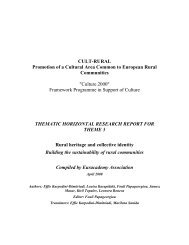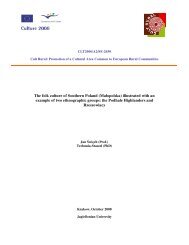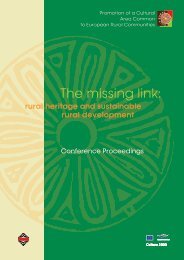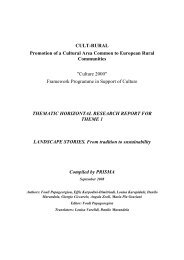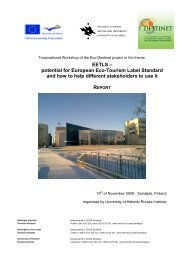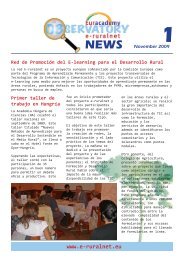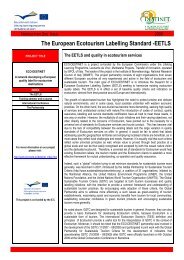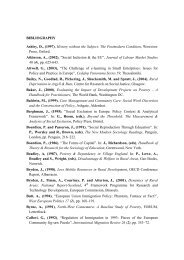Rapporteur seminar report
Rapporteur seminar report
Rapporteur seminar report
Create successful ePaper yourself
Turn your PDF publications into a flip-book with our unique Google optimized e-Paper software.
CONTENTSPAGE1. Introduction 12. Lifelong Learning for Social Inclusion 23. What is the Objective of LLL? 34. Resources for LLL 45. Common Issues / Different Issues 66. EU-15 and New Member States 77. Finally 71
1. IntroductionThis project on Lifelong Learning for Social Inclusion is funded under the EuropeanCommission’s call for proposals, Evaluation of the Impact of Inclusion Policies under theOpen Method of Co-ordination (Budget Heading 04.04.02.02). To complete the project, atransnational <strong>seminar</strong> was held in the Danish National Institute of Social Research on 20November, 2006, at which the project partners presented the results of their nationalstudies.The Lisbon European Council set the objective of integrating all economic, employment,social cohesion and environmental actions into a single EU strategy. It identified educationand training as one of the key policy area for achieving the Lisbon goals. It recognised thatthe absences of skills and qualifications can be a major barrier to inclusion in ‘the mostcompetitive and dynamic knowledge-based society in the world’ and asserts that:Europe’s education and training systems need to adapt both to the demand of theknowledge society and to the need for an improved level and quality of employment. Theywill have to offer learning and training opportunities tailored to target groups at differentstages of their lives: young people, unemployed adults and those in employment who are atrisk of seeing their skills overtaken by rapid change. 1In this context, the promotion of lifelong learning (LLL) is considered important inpromoting social inclusion in European society and labour market and the EuropeanCouncil, at its next meeting in Santa Maria da Feira (June, 2000), declared that:Lifelong learning is an essential policy for the development of citizenship, social cohesionand employment. The Member States, the Council and the Commission are invited, withintheir areas of competence, to identify coherent strategies and practical measures with aview to fostering lifelong learning for all, to promote the involvement of social partners, toharness the full potential of public and private financing and to make higher educationmore accessible to more people as part of a lifelong learning strategy. 2To implement this commitment, the European Commission published a Communication in2001, setting out the key advantages of LLL to realising the goals of the Lisbon Strategy:‣ Offering tailored learning opportunities to individual citizens at all stages of their lives;‣ The promotion of employability and social inclusion through investment in citizens’knowledge and competences;‣ The creation of an information society for all;1 Presidency Conclusions, Lisbon European Council, (23-24 March, 2000), paragraph 25.2 Presidency Conclusions, Santa Maria da Feira European Council (19/20 June, 2000), paragraph 332
‣ The fostering of mobility. 3The Communication sees LLL as providing European citizens with four broad and mutuallysupporting benefits - personal fulfilment; active citizenship; social inclusion; andemployability/adaptability. It defines LLL as covering all formal, informal and non-formallearning andAll learning activity undertaken throughout life, with the aim of improving knowledge, skilland competences within a personal civic, social and/or employment-related perspective.It also considered equality of opportunity as a central element of LLL, ‘both in terms ofgender mainstreaming and making learning genuinely available for all, withoutdiscrimination … not least because of the way in which knowledge and competencesimpact on citizens’ opportunities’.2. Lifelong Learning for Social InclusionTo support these objectives, the European Commission funded this project on LLL, coordinatedby Euracademy Association (Greece) working with partner organisations fromsix Member States. 4 The aims of this project were to investigate the extent of LLL withinthe EU Member States, in particular around the social and economic inclusion of vulnerablegroups, especially immigrants, ethnic minorities and marginalised rural communities. Itexamined the policies and strategies for LLL in the NAPs/inclusion relating to these targetgroups; other policies, such as on employment, social insurance, culture etc. referred to inthe NAPs/inclusion and directed at these vulnerable groups; the policies adopted by theparticipating Member States to implement and support the actions outlined in the NAPs;and identified the mechanisms used to implement these policies.The project was carried out in each participating country through a literature review ofother research which studied LLL, followed by the research phase, which included:‣ Doing an audit of the NAPs/inclusion;‣ A survey of the relevant State ministries, agencies, organisations and policy-makers ateach level of administration;‣ A survey of the relevant civil organisations – NGOs working for these vulnerablegroups, private and public service providers for LLL;3 Making a European Area of Lifelong Learning a Reality Communication from the Commission Brussels,(November, 2001), COM(2001)678 final4 Denmark; Germany; Greece; Hungary; Poland; and the UK.3
‣ Meetings of focus groups, consisting of all relevant stakeholders, to discuss theprovision of LLL at the local level.Each national partner organisation has drafted a national <strong>report</strong> and a synthesis <strong>report</strong> hasbeen produced by the project co-ordinator and all of these were presented at thetransnational <strong>seminar</strong> on 20 November, 2006, in Copenhagen.3. What is the Objective of LLL?The UK Secretary for Education, Alan Johnson, referred to education as ‘the engine forsocial mobility’ and providing a way out of poverty. 5 However, an ongoing debate withinthe political science community is about the reasons for the State to invest in education andtraining. Is it to facilitate the development of human capital or to enhance social capital?Human capital is about investment in time and money to provide a skilled and qualifiedworkforce for economic development. The OECD defines it as ‘the knowledge, skills andcompetences and other attributes embodied in individuals that are relevant to economicactivity’. 6 It is further argued that investment in education and training produces aneducated workforce which can create, adopt and implement new technologies, consideredessential for economic growth. 7Social capital, on the other hand, focuses on developing social networks, the relationshipswithin and between them, the norms that govern these relationships and the trust on whichthey are built. Social capital is about finding more effective ways for citizens to participatein society. Robert Putman in an article on social capital makes the comparison, as follows:Whereas physical capital refers to physical objects and human capital refers to theproperties of individuals, social capital refers to connections among individuals – socialnetworks and the norms of reciprocity and trustworthiness that arise from them. In thatsense social capital is closely related to what some have called “civic virtue”. Thedifference is that “social capital” calls attention to the fact that civic virtue is mostpowerful when embedded in a sense network of reciprocal social relations. A society ofmany virtuous but isolated individuals is not necessarily rich in social capital. 85 Speech by Alan Johnson, UK Secretary for Education, to the Social Market Foundation, September, 2006.6 Human Capital Investment: An International Comparison OECD, Paris (1998).7 See Human Capital, Technology and Growth in the EU Member States (Ch 4) in Employment in Europe, 2006European Commission, Brussels, (October, 2006)8 Bowling Alone. The collapse and revival of American community, R D Putman, Simon and Schuster,New York (2000)4
According to Nan Lin, Duke University, North Carolina, USA, there are four reasons forinvesting in social capital:‣ It facilitates the flow of information and can provide the individual with access to usefulinformation about opportunities and choices otherwise not available;‣ It provides social ties which can be influential in affecting decisions that can impact onthe individual;‣ It provides the individual with social credentials, giving the possibility of access toresources through relationships and social networks;‣ Social relations reinforce identity - as a member of the social group the individualshares similar interests and resources. 9Where does LLL fit into these two scenarios? Is it purely an investment in human capital,with the objective of increasing the skills and qualifications of the labour force or is it aninvestment in social capital which provides for the wider social development of individuals,networks and communities?The national projects fit into both the human and social capital theories. In the Danish case,for example, the focus of the LLL study was on the labour market integration and educationof immigrants, or the Hungarian project which looked at policies for unemployed personsin rural areas. On the other hand, it could be argued that the ‘social capital’ scenario isfound in the two Polish studies on a) the small schools initiative; and b) for the inclusion ofrural youth. The Swedish study was of particular interest, as it addressed both the humancapital objectives of providing the skills for employment to immigrants but also had a focuson social integration through language training and an understanding of Swedish culture, soas to avoid the development of immigrant ‘ghettoisation’.4. Resources for LLLTo implement any policy area, there are four main resources required, financial input,qualified and skills personnel, the facilities to provide the actions or programmes arisingout of the policy and sufficient time to deliver the policy. These four resource issues arerelevant to LLL in both the social inclusion of immigrants and those living in marginalisedrural communities.9 Building a Network Theory of Social Capital by Nan Lin, Dept of Sociology, Duke University, Connections 22 (1)(1999)5
With regard to the funding of LLL a number of issues arise from the national studies. Forexample, where should the main support come from – the State or should it be dependenton other resources? What would be the reason for the State investing in LLL - is it a socialinvestment or an economic investment? Should the State only invest in education andtraining programmes which will be of value to the economy by providing the workforcewith the skills for employability, or should this investment have wider societal objectives?If programmes are State funded, will that funding be sustainable in terms of planning andstability, in the long-term?In the national studies funding was mainly from the State, as in the Danish and UK cases,but other projects identified funding from a number of other sources. In Greece, forexample, the European Social Fund was a source of funding for the project on theintegration of immigrants and in Hungary the study identified a mix of funding sources,such as the state (44%), the European Social Fund (28%) and local and other contributions(also 28%).In Poland the small schools programme is funded, in part, by the local authorities, while thelocal communities contributed to the refurbishment and financial up-keep of the schools.These schools provide a range of both formal education for children and young people andalso adult education courses for farmers and unemployed people and they are also socialand economic centres in the villages.Many of the projects identified accessing sufficient and continuing funding as a majorbarrier to the success of LLL. This lack of funding restricts the development and expansionof the LLL programmes. In the UK, for example, the challenge of securing funding for LLLfor people living in rural areas is ‘a frustration and it is short-term and has narrow targets’and funding is often linked to numbers and outcomes. In the Polish project for the trainingof rural young people the lack of adequate funding and the poor use of the funds availablewere identified as key difficulties.For LLL programmes to be successful, teachers, trainers and experts are required in theright place at the right time. Even if ‘unlimited’ financial resources are available for aparticular programme but there is a shortage of trained personnel to provide a training or aneducational module, the success of that programme will be impeded. In Spain, for example,the State funded programme for the integration of immigrants includes capacity buildingfor trainers.Third, good quality facilities, including IT and other equipment relevant to the delivery ofthe training/education programmes, are essential for the success and repeating ofprogrammes. Clients will not attend poor quality, unattractive facilities and they will not beencouraged to return, as was demonstrated in the small schools project in Poland.6
Time is the final ‘resource’ needed for LLL. EU governments work to a short timeframe of4 to 5 years (between elections), but ongoing education and training programmes may needa longer period of time to achieve sustainable results. This can be an issue for continuingState commitment to funding, to providing finance for trainers and teachers and foressential facilities. Many of the national studies are ongoing, well established and havebroad political support, as with the range of programmes in the UK or with the Act ofIntegration in Denmark. However, the absence of any political commitment, of a properlegal framework for the operations of LLL and the frequent changes of governments andpolicies in Poland were considered problems for the project for young people in rural areas.5. Common Issues / Different IssuesIn the national studies a number of issues emerged which are common both to immigrantsand to marginalised groups in rural areas. First, there are examples of a lack of motivationto participating in LLL, for example among young people in rural areas in Poland wherethere is a limited level of trust of the system and for immigrants in Denmark where one ofthe results was a lack of motivation among the participants and their reluctance to committhe time to take part in programmes. The most successful programmes were those related tothe labour market and where the participants were involved in the promotion, as found inthe Hungarian study, and ‘the level of motivation increased over time’.Second, in almost all studies the absence of adequate funding was identified as a majorproblem. Third, there is the lack of co-ordinated national approaches to LLL, as in dealingwith rural unemployed in Hungary or with the integration of immigrants in Germany,where ‘there is no comprehensive integration programme’.Another common theme in the projects was the focus in many of them on the education ofchildren and young people. In the studies in Greece, Spain and Denmark LLL forimmigrant children and young people is a key part of the overall objectives, in ruralcommunities in Poland, with the small schools initiative and targeting young people, andalso in the UK, with the policies to support children and young people, through theConnexions, Children’s Service, Local Learning and Skills Council programmes.A number of differences can also be detected, for example transport is an issue in ruralareas when it makes access to LLL programmes a problem, as in Poland and the UK –‘rural communities are not easy to reach’- and the availability of quality infrastructure, suchas education and training facilities in rural areas. With immigrants there is the specificproblem of cultural integration and the lack of a tradition of education and a poor level ofbasic education, as in Spanish and German studies.7
6. EU-15 and New Member StatesA number of key differences between the studies in the old EU-15 and the new EU-10Member States can also be seen. In the new Member States (Hungary and Poland) there isan absence of clear legal and organisational structures to support LLL and a lack ofpolitical commitment to the concept as policies are evolving. On the other hand, in anumber of the older Member States the structures are in place but there is still a lack ofcoherence in the implementation of LLL policies, so, as in the UK, there is a need to reducethe bureaucracy associated with the provision of education and training programmes and, inGermany, the need to build a comprehensive integrated programme.7. FinallyTwo quotes from the <strong>seminar</strong> presentations sum up the importance of LLL, both sociallyand economically:Education is changing rural society (Alina Kozińska-Bałdyga, Poland)It takes ten years to become socially included (Lennart Sundberg, Sweden)To quote the Financial Times:Everything is interesting if looked at in the right way. Education must draw onthe twin drives that reside within all of us: curiosity and humour! 1010 Learning that stays with us for life J Lloyd and J Mitchinson, Financial Times Weekend, 18 November, 20068




